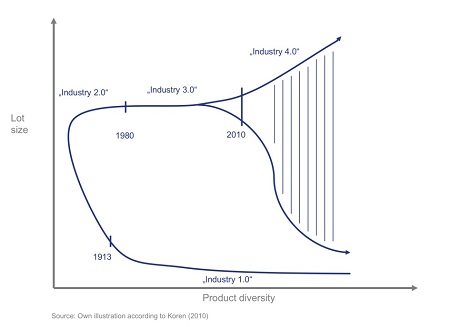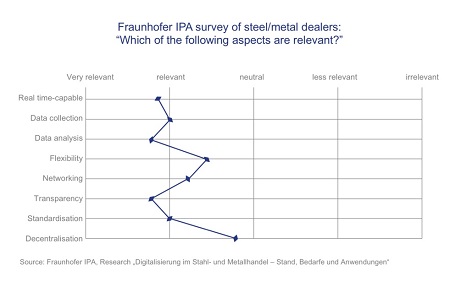
Figure 1: Continuum of potential value creation constellations as industriali-sation and digitalisation changes
The digital era has kicked off two important trends: Firstly, there is a growth in larger companies that can produce efficiently, even smaller ranges of products, thanks to scaling effects. Secondly, there are smaller and more flexible companies that stand out because they can adapt their production systems individually, in some cases, for each customer (Figure 1). Within this continuum of potential value creation possibilities, companies have a wide range of options for using digitalised processes to adjust more quickly to the changing requirements of the customers. However, at the same time, the cost pressure is growing due to the globalised and competitive market. Anyone who invests early in automation can set their production up for the future and quickly turn efficiency profits into competitive advantages.
The industry has a lot of catching up to do
The greatest challenge of further automating operations is linking the sawing process of machines and tools through to the goods management system. And that is because these aspects are still new for the industry: A survey by the Fraunhofer Institute for Production Technology and Automation (IPA) of 66 companies in the metal trade industry showed that 79 percent had no experience with Industry 4.0 applications.* And of the sawing machines used in the German market today, only around 30 percent have a modern digital control unit, globally this figure is only about ten percent. This is why, until now, the companies have largely recorded their data in writing or locally in the machine control unit, although it is often not possible to integrate these data into the digital information systems. In addition, there is a lack of standardised interfaces in the industry to allow data exchange throughout the entire process chain. This means that other machines, periphery and software cannot access machine data; the status of the process and the machine are not transparent. According to the study by the Fraunhofer IPA, transparency is one of the most important aspects of Industry 4.0 (Figure 2). However, the heterogeneous machine landscapes are marked by many different protocols and numerous control systems which makes communication difficult. The higher the level of standardisation of an interface, the lower the integration effort.

Figure 2: Relevance of the various aspects of Industry 4.0 for steel and metal dealers
Current digitalisation projects in the sawing technology field
Various Industry 4.0 solutions for assistance systems, condition monitoring and predictive maintenance applications, or even concepts for tool administration are already available on the market. The latter, for instance, come from the companies iBlade and c-Com: Starting with the number of individual tools and their location in the company through to the tool information with resharpening management, all these can call up and manage relevant information, and even link this to the ordering system. As a result, the value creation chain becomes more transparent, the procurement effort is reduced and redundant structures in the tool history can be avoided.
In addition, the market also offers tools for offering advance support to the machine operator and the process for setting the machine, tool parameters and the program. For instance, the ParaMaster® program by the company WIKUS-Sägenfabrik, which is available online and as a smartphone app, helps to select band saw blades and cutting parameters or determine cutting costs, so that the machine and blade are matched to the optimum. If users follow the recommendations of the tools, they can significantly reduce the costs per cut. With around 4,500 band saw machine data sets from 102 manufacturers and around 60,000 material designations, the tool can represent a large number of application cases. The data base is growing every day and is continuously updated in close cooperation with machine manufacturers. Users receive, quickly and easily, a specific recommendation for band saw blades including the recommended cutting parameters. In addition, users can enter other underlying conditions such as hourly rates for production costs and blade-lives of the band saw blades, and then receive very realistic cutting costs. In conjunction with a QR Code attached to the blade, this further increases the degree of automation with respect to the band saw blade selection. Once the QR Code is scanned with the ParaMaster® app, the blade data are automatically transferred which allows input fields to be avoided. The user only needs to select his machine and the material that is to be sawn, and receives the matching cutting parameters. Also, WIKUS plans to allow the ParaMaster® program to generate offers that suit the machine and application with just a click, thereby saving the user a further time and cost-intensive step.
Outlook
Although there has been some initial success, small and medium-sized companies in particular are still in an early stage where there is still plenty of room for digitalising the business processes. Whilst the possibilities for completely networking the products in the market are still limited, the existing initiatives allow initial tests with digital solutions to highlight the benefits of Industry 4.0, also for sawing technology applications. In the future, platforms and eco-systems will develop where machine and band saw blade manufacturers cooperate with software suppliers to allow further automation. WIKUS is also planning more programs to further digitalise its products and services.
WIKUS will be providing information on digital sawing and possibilities for more efficient sawing during the EMO Hannover 2019 from 16.-21. September, in Hall 15 at Stand E33 and at www.wikus.de














